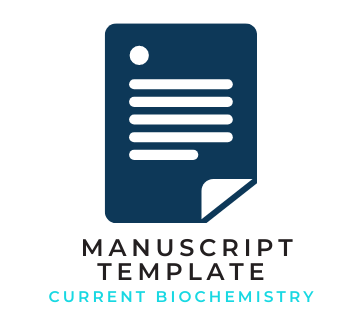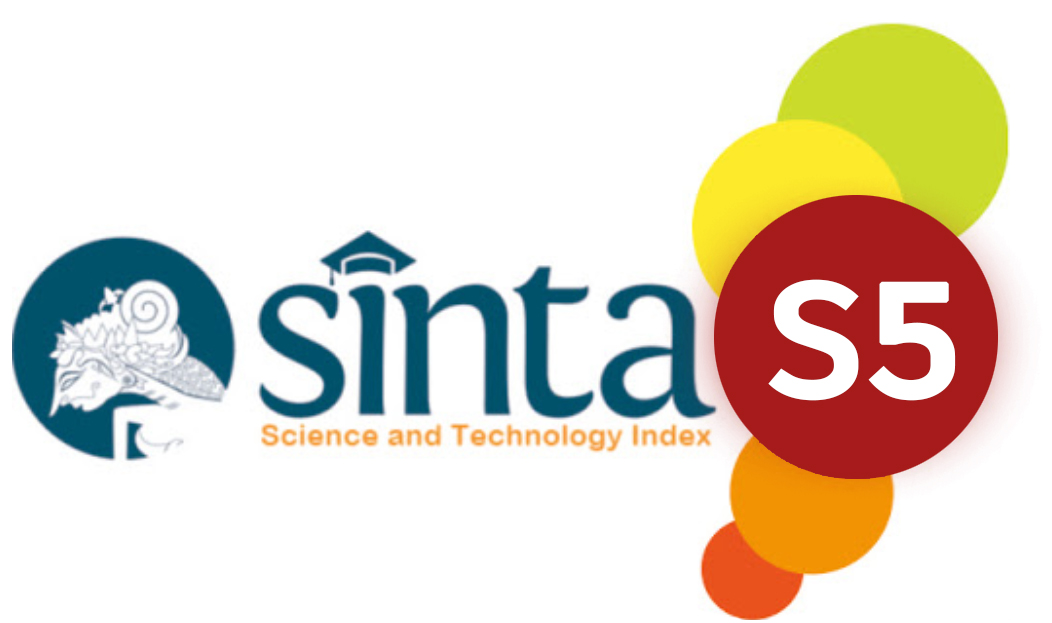Antibacterial Activity of Ethanol Extract from Stem Bark and Leaves of Berenuk (<i>Crescentia cujete</i> L.)
Abstract
Crescentia cujete L. (C. cujete) has been known as a medicine for various diseases that caused by microorganisms. This research was aimed to identify the phytochemical compounds and to determine the antibacterial activity of ethanolic extracts from stem bark and leaves of C. cujete. The phytochemical compounds in both extracts were identified by Harborne method, while antibacterial activity assay was performed by disc diffusion method with the concentration of bacteria 106 cfu/mL. Staphylococcus aureus (S. aureus) and Escherichia coli (E. coli) were used in antibacterial assay. Minimum Inhibitory Concentration (MIC) was obtained by using contact method. The phytochemical compounds analysis showed that ethanol extracts of C. cujete stem bark and leaves contained alkaloids, flavonoids, saponins, tannins, and steroids. The results of antibacterial activity test showed that both extracts have antibacterial activity with the highest inhibition showed by extracts with concentration of 100 %(w/v). The decreased percentage in the number of bacterial colonies on the extracts was less than 90 % so that the MIC value of both extracts against S. aureus could not be determined.
References
Agarwal K, Popli SP. 1992. The constituents of Crescentia cujete leaves. Fitoterapia 63(5):476.
Alay-ay C, Hermoso A, Li R, Quinto M, Santos P, Tan I, Villa M, Cadiang R, Corpuz M. 2016. Hypoglycemic effect of Crescentia cujete Linn. (Bignoniaceae) fruit juice in normal Sprague-Dawley rats. Planta Medica 82(05):PB2. DOI: 10.1055/s-0036-1578650.
[AOAC] Association of Official Analytical Chemist. 2007. Official Methods of Analysis. Ed ke-18. Maryland (US): Association of Official Analytical Chemists.
Ardianti A, Kusnadi J. 2014. Ekstraksi antibakteri dari daun berenuk (Crescentia cujete Linn.) menggunakan metode ultrasonik. Jurnal Pangan dan Agroindustri 2(2):28-35.
[BPOM] Badan Pengawas Obat dan Makanan. 2004. Monografi Ekstrak Tumbuhan dan Obat Indonesia. Jakarta (ID): BPOM RI.
Billacura MP, Laciapag GCR. 2017. Phytochemical screening, cytotoxicity, antioxidant, and anthelmintic property of various extract from Crescentia cujete Linn. fruit. Science International 29(2):31-35.
Borges FRM, Silva MD, Cordova MM, Schambach TR, Pizzolatti MG, Santos ARS. 2014. Anti-inflammatory action of hydroalcoholic extract, dichloromethane fraction and steroid α-spinasterol from Polygala sabulosa in LPS-induced peritonitis in mice. Journal of Ethnopharmacology 151(1):144-150. DOI: 10.1016/j.jep.2013.10.009.
Cosentino S, Tuberoso CIG, Pisano B, Satta M, Mascia V, Arzedi E, Palmas F. 1999. In-vitro antimicrobial activity and chemical composition of Sardinian Thymus essensial oils. Letters in Applied Microbiology 29(2):130-135. DOI: 10.1046/j.1472-765X.1999.00605.x.
Cowan MM. 1999. Plant products as antimicrobial agents. Clinical Microbiology Reviews 12(4): 564-582.
Das N, Islam ME, Jahan N, Islam MS, Khan A, Islam MR, Parvin MS. 2014. Antioxidant activities of ethanol extracts and fractionations of Crescentia cujete leaves and stem bark and the involvement of phenolic compounds. BMC Complementary and Alternative Medicine 14:45-53. DOI: 10.1186/1472-6882-14-45.
Dawodu OA, Lawal OA, Ogunwande IA, Giwa AA. 2016. Volatile constituents of Crescentia cujete L. American Journal of Essential Oils and Natural Products 4(4):1-3.
[Ditjen POM] Direktorat Jendral Pengawas Obat dan Makanan. 2000. Parameter Standar Umum Ekstrak Tumbuhan Obat. Jakarta (ID): Departemen Kesehatan RI.
Edeoga HO, Okwu DE, Mbaebie BO. 2005. Phytochemical constituents of some Nigerian medicinal plants. African Journal of Biotechnology 4(7):685-688.
Ejelonu BC, Lasisi AA, Olaremu AG, Ejelonu OC. 2011. The chemical constituens of calabash (Crescentia cujete). African Journal of Biotechnology 10(84):19631-19636. DOI: 10.5897/AJB11.1518.
Erwin, Saleh C, Purwitassari T. 2012. Uji hipoglikemik
ekstrak metanol daun majapahit (Crescentia cujete (L.))
terhadap kadar glukosa darah mencit jantan. Jurnal Kimia
Mulawarman 9(2): 50-55.
Freitas CS, Baggio CH, Dos Santos AC, Mayer B, Twardowschy A, Luiz AP, Marcon R, Soldi C, Pizzolatti MG, Dos Santos EP, Marques MC, Santos ARC. 2009. Antinociceptive properties of the hydroalcoholic extract, fractions and compounds obtained from the aerial parts of Baccharis illinita DC in mice. Basic and Clinical Pharmacology and Toxicology 104(4):285-292. DOI: 10.1111/j.1742-7843.2008.00367.x.
Fritz SA, Tiemann KM, Hogan PG, Epplin EK, Rodriguez M, Al-Zubeidi DN, Wardenburg JB, Hunstad DA. 2013. A serologic correlate of protective immunity against community-onset Staphylococcus aureus infection. Clinical Infectious Diseases 56(11):1554–1561. DOI: 10.1093/cid/cit123.
Greenwood D. 1989. Antibiotics Sensitivity Testingin Antimicrobial Chemotherapy. Oxford (GB): Oxford University Press.
Hamburger M, Slacanin I, Hostettmann K, Dyatmiko W and Sutarjadi. 1992. Acetylated saponins with molluscicidal activity from Sapindus rarak: Unambiguous structure determination by proton nuclear magnetic resonance and quantitative analysis. Phytochemical Analysis 3(5):231–237.
Harborne BJ. 2008. Phytochemical Methods: A Guide to Modern Techniques of Plant Analysis. New Delhi (IND): Springer India.
Huang H, Xiao X, Ghadouani A, Wu J, Nie Z, Peng C, Xu X, Shi J. 2015. Effects of natural flavonoids on photosynthetic activity and cell integrity in Microcystis aeruginosa. Toxins 7(1):66-80. DOI: 10.3390/toxins7010066.
Hutapea JR. 1993. Inventaris Tanaman Obat Indonesia II. Jakarta (ID): Departemen Kesehatan RI.
Kaneko T, Ohtani K, Kasai R, Yamasaki K, Minh Duc N. 1998. n-Alkyl glycosides and p-hydroxybenzoyloxy glucose from fruits of Crescentia cujete. Phytochemistry 47(2):259-263. DOI: 10.1016/S0031-9422(97)00409-3.
Kohanski MA, Dwyer DJ, Collins JJ. 2010. How antibiotics kill bacteria: from targets to networks. Nature Reviews Microbiology 8:423–435. DOI: 10.1038/nrmicro2333.
Kubo I, Muroi H, Himejima M. 1992. Antimicrobial activity of green tea flavor component and their combination effects. Journal of Agricultural and Food Chemistry 40(2):245-248. DOI: 10.1021/jf00014a015.
Kusuma AM, Sulistyo AN, Susanti S, Sabikis S. 2014. Aktivitas penghentian pendarahan luar ekstrak etanol daun berenuk (Crescentia cujete L.) secara in-vivo. Pharmaceutical Sciences and Research 1(2):134-139. DOI: 10.7454/psr.v1i2.3299.
Kusumaningtyas E, Widiati RR, Gholib D. 2008. Uji daya hambat ekstrak dan krim ekstrak daun sirih (Piper betle) terhadap Candida albicans dan Trichophyton mentagrophytes. Dalam: Prosiding Seminar Nasional Teknologi Peternakan dan Veteriner. Inovasi Teknologi Mendukung Pengembangan Agribisnis Peternakan Ramah Lingkungan,Pusat Penelitian dan Pengembangan Peternakan, Balitbang Pertanian, Bogor 11-12 November 2008.
Lee TH, Jung M, Bang MH, Chung DK, Kim J. 2012.Inhibitory effects of a spinasterol glycoside on lipopolysaccharide-induced production of nitric oxide and proinflammatory cytokines via down-regulating MAP kinase pathways and NF-κB activation in RAW264.7 macrophage cells. International Immunopharmacology 13(3):264-270. DOI: 10.1016/j.intimp.2012.05.005.
Luna-Gierke RE, Griffin PM, Gould LH, Herman K, Bopp CA, Strockbine N, Mody RK. 2014. Outbreaks of non-O157 Shiga toxin-producing Escherichia coli infection: USA. Epidemiology and Infection 142(11):2270-2280. DOI: 10.1017/S0950268813003233.
Mahbub KR, Hoq MM, Ahmed MM, Sarker A. 2011. In vitro antibacterial activity of Crescentia cujete and Moringa oleifera. Bangladesh Research Pubublications Journal 5(4):337-343.
Natta L, Orapin K, Krittika N, Pantip B. 2008. Essential oil from five Zingiberaceae for anti-foodborne bacteria. International Food Research Journal 15(3):337-346.
Nurhasanah, Harlia, Adhtiyawarman. 2014. Uji bioaktivitas ekstrak daun maja (Crescentia cujete Linn.) sebagai antirayap. Jurnal Kimia Khatulistiwa 3(3):43-48.
Ogbuagu MN. 2008. The nutritive and anti-nutritive compositions of Calabash (Crescentia cujete) fruit pulp. Journal of Animaland Veterinary Advances 7(9):1069–1072.
Otto M. 2014. Staphylococcus aureus toxins. Current Opinion in Microbiology 17:32-37. DOI: 10.1016/j.mib.2013.11.004.
Pareira SG, de Araujo SA, Guilhon GMSP, Santos LS, Junior LMC. 2017. In vitro acaricidal activity of Crescentia cujete L. fruit pulp against Rhipicephalus microplus. Parasitology Research 116(5):1487-1493. DOI: 10.1007/s00436-017-5425-y
Parvin MS, Das N, Jahan N, Akhter MA, Nahar L, Islam ME. 2015. Evaluation of in vitro anti-inflammatory and antibacterial potential of Crescentia cujete leaves and stem bark. BMC Research Notes 8:412-418. DOI: 10.1186/s13104-015-1384-5.
Pasicolan VLL, Juan MECS, Cachero EE, de Panay CA, Gestupa LGN, Sarona GJN, Tahad JD. 2014. Flavonoid screening and antiplatelet aggregation activity of miracle fruit. Root Gatherers 7(2014):74-89.
Pelczar MJ, Chan ECS. 2007. Dasar-Dasar Mikrobiologi. Volume ke-1. Hadioetomo RS, Imas T, Tjitrosomo SS, Angka SL, penerjemah. Jakarta (ID): UI Press. Terjemahan dari: Elements of Microbiology.
Ramos MPO, Silva GDF, Duarte LP, Peres V, Miranda RRS, de Souza GHB, Belinelo VJ, Filho SAV. 2010. Antinociceptive and edematogenic activity and chemical constituents of Talinum paniculatum Willd. Journal of Chemical and Pharmaceutical Research 2(6):265-274.
Rinawati ND. 2011. Daya antibakteri tumbuhan majapahit (Crescentia cujete L.) terhadap bakteri Vibrio alginolyticus [skripsi]. Surabaya (ID): Institut Teknologi Sepuluh November.
Safirah R, Widodo N, Budiyanto MAK. 2016. Uji efektifitas insektisida nabati buah Crescentia cujete dan bunga Syzygium aromaticum terhadap mortalitas Spodoptera litura secara in vitro sebagai sumber belajarbiologi. Jurnal Pendidikan Biologi Indonesia 2(3):265-276. DOI: 10.22219/jpbi.v2i3.3874.
Safithri M, Kurniawati A and Syaefudin. 2016. Formula of Piper crocatum, Cinnamomum burmanii, and Zingiber officinale extracts as a functional beverage for diabetics. International Food Research Journal 23(3):1123-1130.
Sani RN, Nisa FC, Andriani RD, Maligan JM. 2014. Analisis rendemen dan skrining fitokimia ekstrak etanol mikroalga laut Tetraselmis chuii. Jurnal Pangan dan Agroindustri 2(2):121-126.
Sembiring BB, Suhirman S. 2014. Pengaruh Cara Pengeringan dan Teknik Ekstraksi Terhadap Kualitas Simplisia dan Ekstrak Meniran. Prosiding Seminar Nasional Pengembangan Teknologi Pertanian Politeknik Negeri Lampung, Lampung 24 Mei 2014.
Setiafianti EM, Kusuma SAF, Ramdhani D. 2017. Effect of drying time and temperature on water content of klutuk banana (Musa balbisiana Colla) flour. International Journal of Scientific Engineering and Applied Science 3(7):87-93.
Silhavy TJ, Kahne D, Walker S. 2010. The bacterial cell envelope. Cold Spring Harbor Perspective in Biology 2:a000414. DOI: 10.1101/cshperspect.a000414
Savolainen H. 1992. Tannin content of tea and coffee. Journal of Applied Toxicology 12(3):191-192. DOI: 10.1002/jat.2550120307.
Sulistiyani, Falah S, Wahyuni WT, Sugahara T, Tachibana S, Syaefudin. 2014. Cellular mechanism of the cytotoxic effect of extracts from Syzygium polyanthum leaves. American Journal of Drug Discovery and Development 4(2):90-101. DOI: 10.3923/ajdd.2014.90.101
Sutjipto S, Wahju JP, Widiastuti Y. 2009. Pengaruh cara pengeringan terhadap perubahan fisikokimia daun kumis kucing (Orthisipon stamineus Benth). Jurnal Tumbuhan Obat Indonesia 2(1):24-27.
Syaefudin, Safithri M and Hasanah U. 2016. Stabilitas total fenolik, aktivitas antioksidan, dan aktivitas penghambatan α-glukosidase pada minuman fungsional berbasis sirih merah (Piper crocatum Ruiz & Pav.). Jurnal Gizi dan Pangan 11(2):83-90.
Syaefudin, Wahyuni WT, Artika IM, Sulistiyani. 2014. Antioxidant activity of flavonoid from Guazuma ulmifolia Lamk. leaves and apoptosis induction in yeast cells. Journal of Biological Sciences 14(4):305-310. DOI: 10.3923/jbs.2014.305.310
Tortora GJ, Funke BR, Case CL. 2007. Microbiology. Ed Ke-9. San Fransisco (US): Pearson Education.
Trevisan G, Rossato MF, Walker CI, Klafke JZ, Rosa F, Oliveira SM, Tonello R, Guerra GP, Boligon AA, Zanon RB, Athayde ML, Ferreira J. 2012. Identification of the plant steroid α-spinasterol as a novel transient receptor potential vanilloid 1 antagonist with antinociceptive properties. The Journal of Pharmacology and Experimental Therapeutics 343(2012):258-269. DOI: 10.1124/jpet.112.195909.
Ulett GC, Totsika M, Schaale K, Carey AJ, Sweet MJ, Schembri MA. 2013. Uropathogenic Escherichia coli virulence and innate immune responses during urinary tract infection. Current Opinion in Microbiology 16(1):100-107. DOI: 10.1016/j.mib.2013.01.005
Wahyuni R, Guswandi, Rivai H. 2014. Pengaruh cara pengeringan dengan oven, kering angin, dan cahaya matahari langsung terhadap mutu simplisia herba sambiloto. Jurnal Farmasi Higea 6(2):126-133.
Yani A. 2004. Fraksinasi komponen aktif antibakteri ekstrak kulit batang tanaman berenuk (Crescentia cujete L.) [skripsi]. Bogor (ID): Institut Pertanian Bogor.
Zhu J, Wang M, Wen W and Yu R. 2015. Biosynthesis and regulation of terpenoid indole alkaloids in Catharanthus roseus. Pharmacognosy Review 9(17):24-28. DOI: 10.4103/0973-7847.156323.









